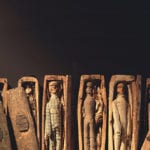 Music
Music  Music
Music  History
History 10 Less Than Jolly Events That Occurred on December 25
 Weird Stuff
Weird Stuff 10 Funny Ways That Researchers Overthink Christmas
 Politics
Politics 10 Political Scandals That Sent Crowds Into the Streets
 Weird Stuff
Weird Stuff Ten Bizarre Facts About The Doge Meme
 Our World
Our World 10 Ways Your Christmas Tree Is More Lit Than You Think
 Movies and TV
Movies and TV The 10 Coolest Stars to Set Sail on The Love Boat
 History
History 10 Things You Didn’t Know About the American National Anthem
 Technology
Technology Top 10 Everyday Tech Buzzwords That Hide a Darker Past
 Humans
Humans 10 Everyday Human Behaviors That Are Actually Survival Instincts
 Music
Music 10 Surprising Origin Stories of Your Favorite Holiday Songs
 History
History 10 Less Than Jolly Events That Occurred on December 25
 Weird Stuff
Weird Stuff 10 Funny Ways That Researchers Overthink Christmas
Who's Behind Listverse?

Jamie Frater
Head Editor
Jamie founded Listverse due to an insatiable desire to share fascinating, obscure, and bizarre facts. He has been a guest speaker on numerous national radio and television stations and is a five time published author.
More About Us Politics
Politics 10 Political Scandals That Sent Crowds Into the Streets
 Weird Stuff
Weird Stuff Ten Bizarre Facts About The Doge Meme
 Our World
Our World 10 Ways Your Christmas Tree Is More Lit Than You Think
 Movies and TV
Movies and TV The 10 Coolest Stars to Set Sail on The Love Boat
 History
History 10 Things You Didn’t Know About the American National Anthem
 Technology
Technology Top 10 Everyday Tech Buzzwords That Hide a Darker Past
 Humans
Humans 10 Everyday Human Behaviors That Are Actually Survival Instincts
Ten Acting Pairs Almost Cast in Romantic Hollywood Films
Everyone loves a good romance, whether it be a witty “rom-com,” a tearjerker melodrama, or an epic set against a historical backdrop. OK, maybe not everyone, but certainly many romantic films rank among the most memorable and critically acclaimed motion pictures ever made and are some of the most popular.
Even today, when adjusted for monetary inflation, 1939’s romantic epic Gone with the Wind remains the highest-grossing film in cinema history. But what would have happened had other lead actors and actresses been cast in the lead roles of these movie classics? Would it have worked, or would they have flopped?
Here is a list of ten of the most popular romantic films and the pairs who were almost originally cast in the lead roles.
Related: 10 Hollywood Stars’ Curious Movie Debuts
10 Pretty Woman: Burt Reynolds and Meg Ryan
Burt Reynolds was the king of motion pictures in the 1970s and was cast in some of the most successful box office hits of that decade. After a breakout role in John Boorman’s critically acclaimed survivalist thriller Deliverance (1972), Reynolds rocketed to fame in movies such as The Longest Yard (1974) and Smokey and the Bandit (1977). Likewise, Meg Ryan emerged as one of the most popular leading ladies of the 1990s, scoring with hits such as You’ve Got Mail (1998) and Kate & Leopold (2001).
So, how could such a pairing not be box-office gold? Unfortunately, we’ll never know. But before you judge each too harshly for turning down the roles of Edward Lewis and Vivian Ward (who would become iconic parts for Richard Gere and Julia Roberts), consider this: Reynolds turned down Pretty Woman in 1990 to accept the lead role in the CBS sitcom Evening Shade, a part that netted him the only Emmy Award in his career.
Meanwhile, coming off the success of 1989’s When Harry Met Sally, and three years from being cast in Sleepless in Seattle, turning down the role that made Roberts a star hardly slowed down Ryan’s career. Call it a “win-win” for everyone! Also, Garry Marshall had initially envisioned the lead roles going to Al Pacino and Michelle Pfeiffer. Another pairing that just doesn’t seem quite right.[1]
9 An Affair to Remember: Fernando Lamas and Arlene Dahl
Few actors in the 1950s were as debonair as Cary Grant. Ironically, only a couple of decades earlier, Grant was better known for comedic parts in films such as Bringing Up Baby (1938) and Arsenic and Old Lace (1943) than the suave leading man roles he would later play. However, when veteran director Leo McCarey decided to remake his 1939 romance classic Love Affair, he envisioned it as a vehicle for husband and wife team Fernando Lamas and Arlene Dahl.
Considering the success of another married acting couple in 1957, I Love Lucy’s Desi Arnaz and Lucille Ball, matching the Argentinian Lamas and the redheaded Dahl made sense as a variation of the Cuban Arnaz and the carrot-topped Ball pairing.
But as fate would have it, An Affair to Remember (1957) would be cast with Grant and the six-time Academy Award nominee, Deborah Kerr. The casting decision proved to be the right one. In 2002, the American Film Institute ranked the movie as the fifth most romantic film of all time. But it was a tough break for Lamas and Dahl, who not only lost the iconic roles but also would divorce just three years later. [2]
8 The Bishop’s Wife: Dana Andrews and Teresa Wright
A Christmas classic that has become a perennial fan favorite in recent decades is yet another film that starred the prolific romantic leading man Cary Grant. But he was not the original choice to play the angel Dudley in Henry Koster’s beloved romantic comedy The Bishop’s Wife in 1947. Hoping to cash in on the popular pairing of Dana Andrews and Teresa Wright, who both gave memorable performances a year earlier in the acclaimed post-World War II drama The Best Years of Our Lives (1946), producer Samuel Goldwyn planned to cast each as the bishop and his wife, with David Niven as Dudley.
However, when Wright declined the role after becoming pregnant, Goldwyn was forced to loan out Andrews to RKO, who, in return, released Loretta Young to play the title role. Grant then joined the production only to have director Koster pull another casting switch. Instead of replacing Andrews as the bishop, Grant was cast as the angel. Reluctantly, Niven acquiesced to being assigned the bishop role. Although initially disappointing at the box office, the film has slowly grown in popularity and in 1996 was remade as The Preacher’s Wife, starring Denzel Washington and Whitney Houston.[3]
7 Rocky: James Caan and Carrie Snodgress
With multiple sequels and antagonists who might as easily fit into the Marvel universe as they would into a sports movie franchise, there are three basic facts many forget about the movie that spawned it all: Rocky. First of all, the 1976 film won the Oscar for Best Picture. Secondly, Sylvester Stallone was virtually an unknown actor at that time, and it almost cost him the title role. And third, how much boxing was actually in the film? Not much. Because Rocky—at its core—is not a true sports film. “It’s a love story,” to quote the actor who played champion Apollo Creed, Carl Weathers.
Executives at United Artists loved Sylvester Stallone’s script for the film, but they wanted a bankable star to play the lead. Coming off the success of testosterone-driven films like Rollerball (1975) and the “guy-cry” TV classic Brian’s Song (1971), who better to play the “Italian Stallion” than the actor previously cast as The Godfather’s oldest son, James Caan? To play Rocky’s love interest Adrian, Carrie Snodgress, who inspired Neil Young to write “A Man Needs a Maid” in 1972, was the frontrunner.
According to Stallone, Adrian was originally supposed to be Irish, and he wanted Harvey Keitel to play her brother. Who knows? With Martin Scorsese directing, this might have worked.[4]
6 Grease: Henry Winkler and Marie Osmond
Few movies in the 1970s could boast the popularity of the musical romantic comedy Grease. Adapted from a Broadway musical, Grease (1978) became the highest-grossing film musical of all time, a record that would stand for the next 30 years. The popularity of actor John Travolta and singer Olivia Newton-John exploded after playing the iconic leads roles of Danny and Sandy. Travolta emerged as a major box-office draw, and for Newton-John, it helped cultivate a new image for her as a singer. But neither was the first choice for either plumb role.
At the peak of his fame as “Fonzie,” the bad-boy tough guy on TV’s Happy Days, Henry Winkler was first offered the role of Danny. To play Sandy, another popular TV star and teen idol was considered: Marie Osmond. Winkler, hoping to avoid being typecast as a “greaser,” passed on the role. Osmond, fearing the rebel transformation of Sandy would hurt her image, also turned her offer down, as did brother Donny who rejected the offer to play the “Teen Angel.” In one of the worst career decisions ever, both Donny and Marie opted to star in the critical and commercial failure Goin’ Coconuts instead.[5]
5 Ghost: Bruce Willis and Michele Pfeiffer
Who can forget the iconic pottery wheel scene in which Patrick Swayze’s Sam romantically caresses and kisses Demi Moore’s Molly to the soulful rendition of The Righteous Brothers’ “Unchained Melody” in the fantasy thriller Ghost (1990)? Now, picture the same scene with Moore’s then-husband and Die Hard star Bruce Willis and the woman, who a year earlier gave one of her most acclaimed performances singing “Makin’ Whoopee” on top of a piano in The Fabulous Baker Boys, Michele Pfeiffer. It’s an interesting idea that had potential.
However, it was Moore’s uncanny ability to cry on cue, out of either eye, that ultimately won her the part over Pfeiffer, Meg Ryan, Julia Roberts, and Nicole Kidman, among others considered for the part of Molly. Willis candidly admitted he didn’t understand the script when he read it and later considered himself a “knucklehead” for rejecting the offer to star in what would become the highest-grossing film of 1990. He thought the concept of a romance between a ghost and a living person wouldn’t work. Apparently, Willis learned his lesson and starred in the acclaimed The Sixth Sense in 1999, which of all things depicted a child who could see “dead people.”[6]
4 Doctor Zhivago: Peter O’Toole and Sophia Loren
If there was ever a romantic epic with a greater historical sweep than Gone with the Wind, it has to be David Lean’s adaptation of Boris Pasternak’s novel Doctor Zhivago. With an all-star cast including Sir Alec Guinness and Academy Award-winning actor Rod Steiger, today the film is the eighth highest-grossing film of all time, adjusted for ticket-price inflation.
Omar Sharif, in the title role, never looked more dashing, and Julie Christie as his muse Lara never looked more beautiful. However, neither were Lean’s first choices. Peter O’Toole, who starred in Lean’s previous film Lawrence of Arabia, was his original choice for Zhivago. Producer Carlo Ponti believed his wife, international sex symbol Sophia Loren, was tailor-made for Lara. However, O’Toole had no interest in participating in another grueling epic production. And few believed Loren would be believable playing a young, virginal schoolgirl in the movie’s early scenes.
Reportedly, American filmmaker John Ford recommended Christie after directing her in Young Cassidy, while fellow actor Michael Caine suggested Sharif after reading for the part of Zhivago himself. Regardless, it’s hard to argue with the final casting of a movie that today ranks among the greatest epic romances of all time.[7]
3 Titanic: Matthew McConaughey and Gwyneth Paltrow
I’ve often wondered why so few seem to notice that Kate Winslet as young Rose in Titanic (1997) bears little resemblance to a young Gloria Stuart, who played the elderly version of the same character in the film. Perhaps that’s because other actresses were considered for the part of Rose DeWitt Bukater long before the British actress secured the role.
A leading contender who director James Cameron considered to play the heroine of his fictionalized historical epic was an actress who was only one year away from winning the Academy Award for Best Actress, Gwyneth Paltrow. As a slender blonde with an aristocratic bearing, Paltrow would have seemed a much stronger physical match for the actress who would play her as an elderly woman.
To play Jack, a part that elevated Leonardo DiCaprio to superstardom, Matthew McConaughey was strongly considered. Ultimately, Cameron deemed McConaughey too old for the part and went with DiCaprio, who could have passed for a teenager in 1997. After campaigning heavily to play Rose, Winslet’s screen test convinced the director she was made for the role. Eleven Oscars later and with over two billion dollars in profits earned by Titanic, it’s hard to argue with Cameron’s decisions. It’s a good thing, too as I simply cannot picture Jack telling Rose, “It’s all right, all right, all right,” as she promises him she’ll never let go.[1]
2 Gone With the Wind: Gary Cooper and Paulette Goddard
Never known for subtlety, Cecil B. DeMille’s epic films were as brash and bombastic as the man himself. After the release of his epic adventure Unconquered in 1947, Time magazine called the movie a “Technicolor celebration of Gary Cooper’s virility, Paulette Goddard’s femininity, and the American frontier spirit.” Critic Emanuel Levy later echoed it was “the sex appeal of the actors that made the film popular.”
Perhaps it was this on-screen chemistry that almost led David O. Selznick a mere eight years earlier to cast both as the leads in his epic adaptation Gone with the Wind. Goddard would be the only actress other than Vivien Leigh who would complete a Technicolor screen test for the part of Scarlett O’Hara after emerging as a finalist for the highly sought-after role. Although Clark Gable was Selznick’s first choice for Rhett Butler, Cooper was also seriously considered until producer Sam Goldwyn, who he was contracted to, refused to loan him out.
Considering the massive box office success and long-term popularity of Gone with the Wind, it’s hard to argue with the Leigh/Gable pairing. But if you want to get a glimpse of what might have been, check out Unconquered one free evening.[9]
1 Casablanca: George Raft and Michele Morgan
It’s the greatest movie of all time—well, after Citizen Kane—if you agree with the American Film Institute’s 1998 “Top 100” list. Whether it is or isn’t, few can question the enduring popularity of Casablanca (1942), a film that has perhaps more memorable lines than any movie ever made. The ill-fated love story of Rick and Ilsa and the chemistry of the film’s two charismatic leads, Humphrey Bogart and Ingrid Bergman, left an indelible mark on audiences that is still felt today.
However, screen legends Bogart and Bergman were not the original choices to play the parts. Warner Brothers studio head Jack Warner envisioned George Raft in the lead, an actor guilty of some of the worst career choices in film history. Raft turned down lead roles in The Maltese Falcon and High Sierra, parts which made Bogart a major Hollywood star. Meanwhile, Bergman nearly lost out the role of Ilsa to another international beauty not as well known to American audiences today, French actress Michele Morgan. But when Morgan asked for $55,000 for a seven-week shoot to play the part, Wallis balked and scooped up Bergman for a mere $25,000. Not a bad price to pay for a career-defining performance![10]








